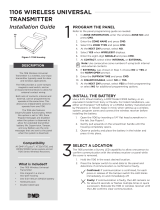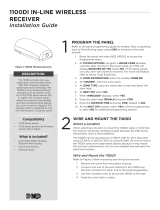La page est en cours de chargement...

1108 DOORBELL MODULE
Installation Guide
DESCRIPTION
Figure1: 1108 Doorbell Module
The 1108Doorbell Module monitors
doorbell button presses. When
someone rings the doorbell, the
module sends a wireless signal
to annunciate at keypads or any
connected 1136Wireless Sounders.
Compatibility
• All panels with firmware Version
192and higher
• Any video or mechanical doorbell
with a standard transformer or a
16‑24VAC wall transformer with
either a mechanical chime or
10Ohm resistor in the circuit
• 7000/9000Series Thinline Series
Keypads with Level J Hardware
or higher
• 7800/9800Series Graphic
Touchscreen Keypads with
Firmware Version 110or higher
What is Included?
• One 1108Doorbell Module
• Hardware pack
1
PROGRAM THE PANEL
When programming the 1108in the panel, refer to the panel
programming guide as needed. If you’ll be using an 1106Wireless
Transmitter for the LED survey, program the transmitter in the
panel while referring to the 1106Installation Guide (LT‑1377).
After completing each of the following steps, press CMD to
advance to the next prompt.
1. Enter6653 (PROG) at the panel keypad and go to ZONE
INFORMATION.
2. At ZONE NO, enter the wireless zone number. Refer to
Figure2for serial number location.
3. At *UNUSED*, enter the zone name.
4. At ZONE TYPE, press any select key or area and select DB
(Doorbell).
5. At the Area Assignment section, select the area.
6. At the NEXT ZONE prompt, select NO.
7. When WIRELESS? displays, select YES.
8. At SERIAL#, enter the eight‑digit device serial number.
9. At SUPRVSN TIME, enter a supervision time. Default is 240.
10. At the NEXT ZONE prompt, select YES if you are finished
programming the zone. Select NO if you would like to access
additional programming options.
11. To save panel programming, go to STOP and press CMD.
2
To select a location, use an 1106Series Universal Wireless
Transmitter to perform an LED survey operation.
1. With the cover removed, hold the module in the desired
location.
2. Press the tamper switch to send a signal to the panel and
determine if communication is confirmed or faulty.
Confirmed: For each press or release of the tamper
switch, the LED blinks immediately on and
immediately o.
Faulty: The module LED remains on for about
8seconds or flashes multiple times in quick
succession.
3. If the transmitter is not communicating with the panel,
start by looking for items that might cause interference,
such as metal objects or electronic equipment. Move the
transmitter or receiver and repeat the survey procedure
until communication is confirmed.
SELECT A LOCATION

2 1108 INSTALLATION GUIDE | DIGITAL MONITORING PRODUCTS
1108 Doorbell
Module
To
Transformer
To
Mechanical or
Video Doorbell
Mechanical
Chime
Front
Trans
Rear
Power Booster
(optional)
C
(RED/WHITE)
TI
(BLACK)
T2
(RED)
Figure3: 1108Wiring with Existing Chime
Figure4: 1108Wiring without Chime
1108 Doorbell
Module
To
Transformer
To
Mechanical or
Video Doorbell
10 Ω
Resistor
C
(RED/WHITE)
TI
(BLACK)
T2
(RED)
WIRE THE 1108
3
The 1108is intended to be wired between the mechanical chime or resistor and transformer. For wiring with
an existing chime, refer to Figure3. For wiring with a resistor instead of a chime, refer to Figure4. Refer to
Figure2for 1108PCB details and terminal numbers,
Caution: Disconnect all power from the doorbell and turn o the correct breakers before wiring
the 1108.
1. Connect the black wire from the module T1terminal to the wire that runs from the transformer to the
doorbell.
2. Connect the red wire from the module T2terminal to the transformer.
3. Connect the red/white wire from the module
C terminal to the chime TRANS terminal or
to one leg of the 10Ohm resistor. Ensure the
current from the transformer is flowing through
the 1108from the incoming red wire to the
outgoing red/white wire.
4. Connect a wire from the chime FRONT terminal
or resistor leg to the doorbell. If using a power
booster, connect one wire to the chime TRANS
terminal and the other to the FRONT terminal.
5. Turn on breakers and restore power to the
doorbell.
Serial
Number
Survey
LED
RED
RED/WHITE
BLACK
C
T1
Model 1108
T2
Figure2: PCB Features

1108 INSTALLATION GUIDE | DIGITAL MONITORING PRODUCTS 3
MOUNT THE 1108
Mount the 1108to the inside of the mechanical chime housing with double‑sided tape. Do not mount the
module on a metal surface to avoid interference with the mechanical chime operation. Additionally, the module
can be mounted outside the mechanical chime housing for best wireless performance.
4
5
WALK TEST THE 1108
After the 1108has been installed, test to confirm that it is communicating reliably with the panel. Use the Tech
APP™ to perform a Wireless Walk Test on the system or follow these steps to perform a Walk Test from a
keypad that is connected to the panel:
1. At the keypad, enter 8144 (WALK) and select WLS.
2. If the module fails to check in at the keypad, ensure that it is wired properly and check for sources of
interference such as metal objects and electronic equipment.
ADDITIONAL INFORMATION
LED Operation
The 1108Doorbell Module provides survey LED capability that allows an installer to confirm communication with the
panel or receivers while the cover is removed. If the 1108is communicating properly, each press or release of the doorbell
button will cause the module LED to blink immediately on and immediately o. The LED remains o when the module
is synced with the panel. If communication is faulty, the module LED remains on for about 8seconds or flashes multiple
times in quick succession.

Designed, engineered, and
manufactured in Springfield, MO
using U.S. and global components.
LT-1919 19172
1108 DOORBELL MODULE
Specifications
Primary VAC - VAC
Frequency Range - MHz
Dimensions
Transmitter ” L x ” W x ” H
Housing
Color White
Material Flame-Retardant ABS
Patents
US Patent No
Certifications
FCC Part CCKPC
Industry Canada A-PC
INTRUSION • FIRE • ACCESS • NETWORKS
2500 North Partnership Boulevard
Springfield, Missouri 65803-8877
800.641.4282 | DMP.com
FCC INFORMATION
This device complies with Part 15 of the FCC Rules. Operation is subject to the following two conditions:
1. This device may not cause harmful interference, and
2. This device must accept any interference received, including interference that may cause undesired operation.
The antenna used for this transmitter must be installed to provide a separation distance of at least 20cm (7.874 in.) from
all persons. It must not be located or operated in conjunction with any other antenna or transmitter.
Changes or modifications made by the user and not expressly approved by the party responsible for compliance could
void the user’s authority to operate the equipment.
Note: This equipment has been tested and found to comply with the limits for a Class B digital device, pursuant to
part 15 of the FCC Rules. These limits are designed to provide reasonable protection against harmful interference in
a residential installation. This equipment generates, uses and can radiate radio frequency energy and, if not installed
and used in accordance with the instructions, may cause harmful interference to radio communications. However,
there is no guarantee that interference will not occur in a particular installation. If this equipment does cause
harmful interference to radio or television reception, which can be determined by turning the equipment o and on,
the user is encouraged to try to correct the interference by one or more of the following measures:
1. Reorient or relocate the receiving antenna.
2. Increase the separation between the equipment and receiver.
3. Connect the equipment into an outlet on a circuit dierent from that to which the receiver is connected.
4. Consult the dealer or an experienced radio/TV technician for help.
INDUSTRY CANADA INFORMATION
This device complies with Industry Canada License-exempt RSS standard(s). Operation is subject to the following two
conditions:
1. This device may not cause interference, and
2. This device must accept any interference, including interference that may cause undesired operation of the device.
This system has been evaluated for RF Exposure per RSS-102 and is in compliance with the limits specified by Health
Canada Safety Code 6. The system must be installed at a minimum separation distance from the antenna to a general
bystander of 7.87 inches (20 cm) to maintain compliance with the General Population limits.
Le présent appareil est conforme aux CNR d’Industrie Canada applicables aux appareils radio exempts de licence.
L’exploitation est autorisée aux deux conditions suivantes:
1. l’appareil ne doit pas produire de brouillage, et
2. l’utilisateur de l’appareil doit accepter tout brouillage radioélectrique subi, même si le brouillage est susceptible
d’en compromettre le fonctionnement.
L’exposition aux radiofréquences de ce système a été évaluée selon la norme RSS-102 et est jugée conforme aux limites
établies par le Code de sécurité 6 de Santé Canada. Le système doit être installé à une distance minimale de 7.87 pouces
(20 cm) séparant l’antenne d’une personne présente en conformité avec les limites permises d’exposition du grand
public.
/






